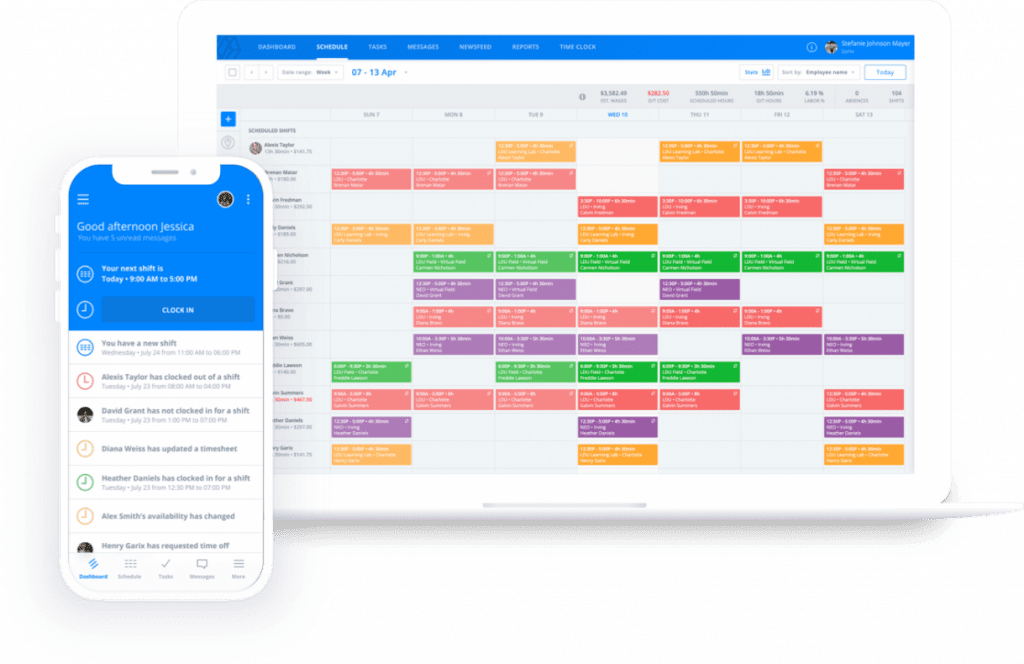13 Employee Satisfaction Survey Questions To Ask Your Team
Want to help your employees feel happy and content with their jobs and work envi...

If you’re looking for ways to increase employee happiness in your business, you’ve come to the right place. In this article, the workforce management experts at Sling offer tips to help make your business a better, happier place to work.

No one wants to work in a sad, depressing, oppressive environment. That’s just a recipe for disaster and failure.
Employee happiness matters because team members who feel good while at work are:
It’s easy to see how training your employees to be happy at work can pay very real dividends to your business as a whole.

One of the best and easiest ways to start your business on the path to better employee happiness is to ask your team members about it directly. And the best way to do that is to administer an employee satisfaction survey.
An employee satisfaction survey gives you insight into how your team feels about their day-to-day activities and other key aspects of your business. Think of it as the foundation of a happy team.
When you find out how your employees feel about their job, you can then implement some of the other suggestions on this list and start to build engagement, passion, commitment, and purpose within your teams and across your whole business.
That’s a recipe for success and happiness, but it all starts with taking the pulse of your team via an employee satisfaction survey.
There are few things more frustrating — and a bigger hit to employee happiness — than not having the tools to do your job effectively and efficiently. So, make sure your team has the tools they need to do the job right.
For example, think about your own job. If you didn’t have X or you had to always do Y before you could do Z, how frustrating would your workday be?
It’s the same for your employees. If they don’t have the simple tools necessary to get their job done in a timely manner, or they always have to recreate the wheel before getting to the primary task, their happiness will suffer.
If you’re having trouble coming up with ways to implement this suggestion, try asking your team directly what they need to make their job better in your employee survey.
The fixes could be simple or complicated, but, whatever they are, giving your team the right tools for the job will boost their happiness.

Employee happiness depends, in large part, on being free to try novel approaches to common problems. To encourage this freedom, give your employees plenty of room to work — and, no, we’re not talking about physical space.
Put another way, don’t micromanage. Instead of watching your team’s every move, give them an assignment and a deadline, and then step back and let them work.
Giving your employees autonomy proves that you trust their abilities. That sense of trust then helps them feel happier while at work.
Another powerful way to increase employee happiness is to recognize work well done whenever it occurs. It doesn’t have to be when your team finishes a project or at the end of the year.
And it doesn’t have to be a grand, expensive gesture. Small rewards more frequently go a long way toward improving happiness, satisfaction, and engagement.
For example, maybe you take a few moments to say “good job” to an employee as you pass them in the hall. Or, maybe, you bring doughnuts to work in the morning when your team is deep into a difficult project.
Think about what your team members need to keep them going, get creative with small, frequent rewards and recognition, and watch workplace happiness soar.
Another powerful way to improve employee happiness is to promote inclusivity.
Workplace inclusivity includes the practices and attitudes of your business that ensure that everyone:
That may sound like a lot, but it boils down to the fact that all team members’ thoughts, ideas, and perspectives matter.
When you develop inclusivity by making everyone feel like a valuable member of the team, you lay the groundwork for their overall happiness to grow and improve as well.

Guidelines and standard operating procedures are the foundation on which your team — and your business — operates. They also have a direct effect on employee happiness.
If you haven’t already, establish clear procedures and instructions for everything that has to do with your business, including:
These instructions serve as a framework for your expectations of the day-to-day activities in your business.
Rather than relying on word of mouth or endless team meetings to make these guidelines clear, produce an employee handbook that is available to every employee, all the time.
By doing this, you give your employees a clear path to success because they understand what is expected of them and how they will be evaluated.
Communication is one of the fundamental building blocks of employee happiness as well as an effective team and an effective business.
It’s important to keep in mind that communication is about more than just an exchange of information.
Effective, streamlined communication is also about how well the recipient understands what you’re trying to say. It doesn’t matter if you speak, draw, or write, if the message isn’t clear, your communication will suffer.
You can streamline your team’s communication by:
Making your team communication clearer, more concise, and more effective will dramatically improve not just employee happiness but also the way your business operates.
When you look at your employees’ work habits and preferences, you’ll find that some of them are more efficient in the morning (i.e., 6 a.m. to 12 p.m.), while others are more efficient in the afternoon and evening (i.e., 1 p.m. to 8 p.m.).
To make the most of those peaks in performance, try instituting an alternate work schedule.
Examples include:
Giving your team members the opportunity to work when they feel their best can significantly improve employee happiness and contribute mightily to the success of your business.

While many apps make the scheduling process simpler, only a handful actually provide tools that help you improve employee happiness. Of those, Sling is the best.
Sling’s powerful A.I. allows you to maximize the potential of each shift so you can create the best team for the job while still giving your employees the time off they need.
Sling provides suggestions and notifications when you accidentally double-book someone or you forget to take into account a time-off request. This can help you maintain the happy vibes that you’ve worked so hard to achieve.
And Sling offers even more features to help you maximize workforce management, optimization, and employee happiness, such as:
All of that from one suite of tools. Sling really is the complete solution for scheduling, organizing, managing, and improving the way your team feels at work.
See for yourself what Sling has to offer, try it for free, and get even more free resources to help you manage your business better, organize and schedule your team, and track and calculate labor costs at GetSling.com.
See Here For Last Updated Dates: Link
This content is for informational purposes and is not intended as legal, tax, HR, or any other professional advice. Please contact an attorney or other professional for specific advice.
Schedule faster, communicate better, get things done.